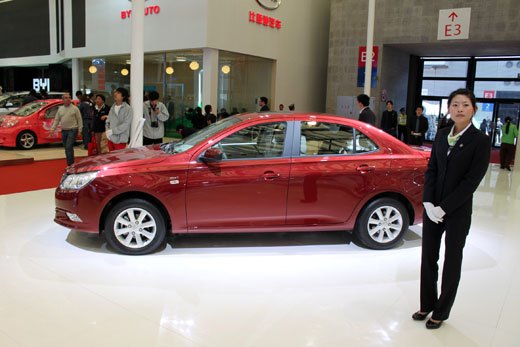GM Invests More Into Fake Chinese Brand

GM added more capacity to its Chinese Baojun brand by opening a factory in Liuzhou, southern China. Plant and brand are part of the SAIC GM Wuling joint venture, where GM holds 44 percent, SAIC 50 percent, with 6 percent held by Wuling.
Baojun started with the Baojun 630, a compact sedan based on an older Buick Excelle/Daewoo Lancetti platform, later the Le Chi was added, a rebadged Chevrolet Spark. By 2015, Baojun wants to have a total of five models, Reuters says.
Baojun is one of China’s joint venture brands, which we at TTAC like to call “fake Chinese brands.”
The joint venture brands saw mixed success. Much to the chagrin of Chinese planners, the foreigners only handed outdated technology down to the joint venture brands. The Baojun brand saw sales as high as 9000 in January, in September, it was down to 6,000 units. Nissan’s Venucia brand likewise saw encouraging sales initially, which soon petered off.
On Matt Gasnier’s list of best-selling cars in China, the Baojun 630 ranked 46th in October 2012.
Brands with a Chinese identity sound like a good idea to protect against the sudden ill will against Japanese products, but it did not work out that way: Sales of Nissan’s Venucia brand more than halved from August to September, while sales of Baojuns rose from some 4,000 in August to over 6,000 in September: Chinese car buyers are not stupid, and are well-informed Internet users. They know exactly that a Venucia is a last generation Nissan Tiida.

Bertel Schmitt comes back to journalism after taking a 35 year break in advertising and marketing. He ran and owned advertising agencies in Duesseldorf, Germany, and New York City. Volkswagen A.G. was Bertel's most important corporate account. Schmitt's advertising and marketing career touched many corners of the industry with a special focus on automotive products and services. Since 2004, he lives in Japan and China with his wife <a href="http://www.tomokoandbertel.com"> Tomoko </a>. Bertel Schmitt is a founding board member of the <a href="http://www.offshoresuperseries.com"> Offshore Super Series </a>, an American offshore powerboat racing organization. He is co-owner of the racing team Typhoon.
More by Bertel Schmitt
Latest Car Reviews
Read moreLatest Product Reviews
Read moreRecent Comments
- Lorenzo This car would have sold better if there was a kit to put fiberglass toast slices on the roof.
- Lorenzo The Malibu is close to what the 1955 Bel Air was, but 6 inches shorter in height, and 3 inches shorter in wheelbase, the former making it much more difficult to get into or out of. Grandma has to sit in front (groan) and she'll still have trouble getting in and out.The '55s had long options lists, but didn't include a 91 cubic inch four with a turbo, or a continuously variable transmission. Metal and decent fabric were replaced by cheap plastic too. The 1955 price was $1765 base, or $20,600 adjusted for inflation, but could be optioned up to $3,000 +/-, or $36,000, so in the same ballpark.The fuel economy, handling, and reliability are improved, but that's about it. Other than the fact that it means one fewer sedan available, there's no reason to be sorry it's being discontinued. Put the 1955 body on it and it'll sell like hotcakes, though.
- Calrson Fan We are already seeing multiple manufacturers steering away from EVs to Hybrids & PHEVs. Suspect the market will follow. Battery tech isn't anywhere close to where it needs to be for EV's to replace ICE's. Neither is the electrical grid or charging infrastructure. PHEV's still have the drawback that if you can't charge at home your not a potential customer. I've heard stories of people with Volts that never charge them but that's a unique kind of stupidity. If you can't or don't want to charge your PHEV then just get a hybrid.
- AZFelix The last time I missed the Malibu was when one swerved into my lane and I had to brake hard to avoid a collision. 1 out of 5⭐️. Do not recommend.
- 2ACL I won't miss it; it was decent at launch, but in addition to the bad packaging, GM did little to keep it relevant in the segment. I'd prefer that another domestic automaker doesn't just give up on the mainstream sedan, but unlike some of Ford's swan songs, the Malibu made an indifferent case for why they should live.


































Comments
Join the conversation
Will China ever have a brand name as respected as Japan's SONY, Panasonic, Mitsubishi or Toshiba? Or will their brand name be MADE IN CHINA?